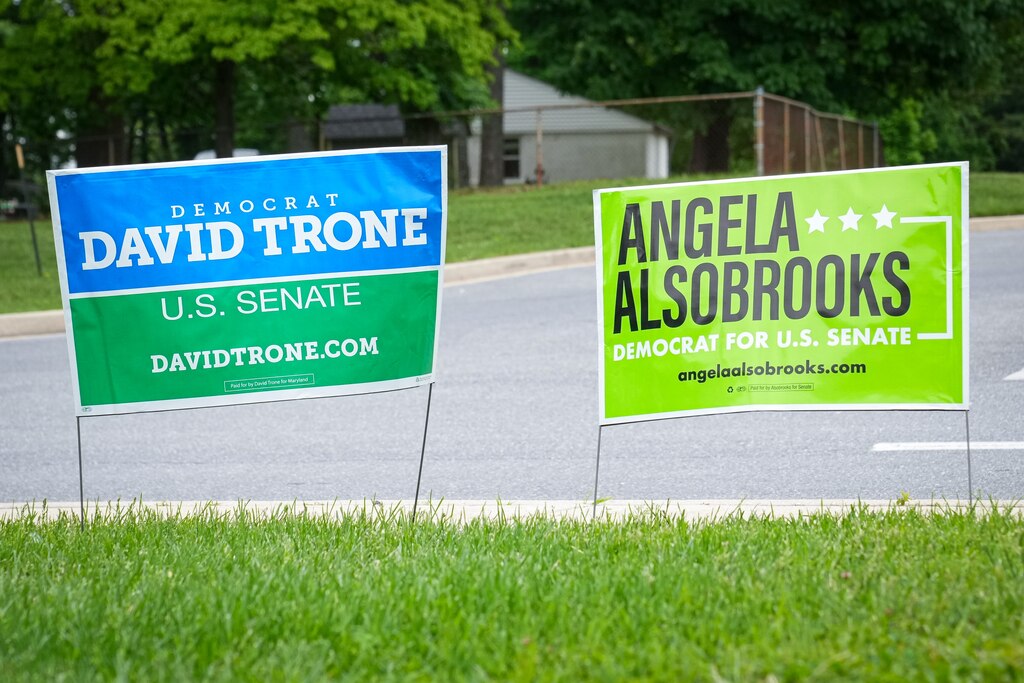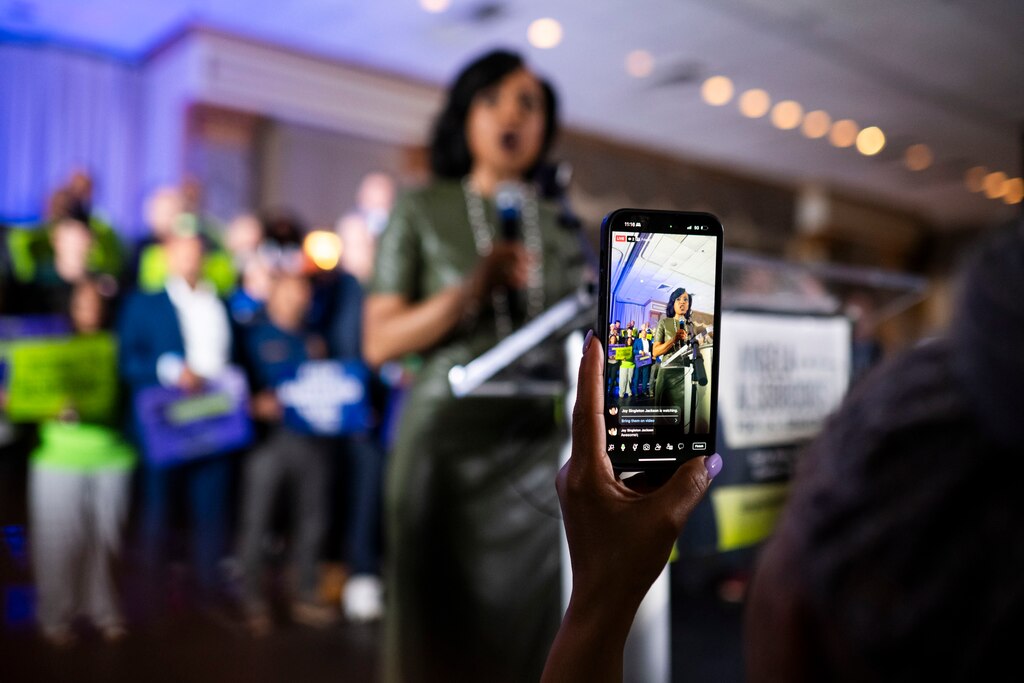For months, Angela Alsobrooks appeared to be in a hole.
Nearly every poll showed her behind David Trone, her chief opponent in Maryland’s Democratic primary for the U.S. Senate.
Every fundraising report showed Trone spending millions upon millions of his own money, while she raised a few million.
And everywhere voters looked, Trone’s ads dominated airwaves and filled mailboxes.
From the outside, it looked like Trone, a three-term member of Congress, might sail past Alsobrooks, in her second term as Prince George’s County executive. As election day approached, the race appeared to tighten and both campaigns quietly suggested it might take a few days to determine a winner.
But as the numbers rolled in Tuesday night it quickly became clear not only that Alsobrooks had won, but she won big. By the end of the night, she held a 54%-42% advantage over Trone. Even with some mail and provisional ballots left to count, there was no way for Trone to win, and he conceded.
“Tonight, we made history,” Alsobrooks told the crowd at her election night party. “And we did it while overcoming steep odds.”
So how did she engineer a come-from-behind win?
According to experts, voters and Alsobrooks’ own campaign team, the 53-year-old used her limited resources strategically to present herself as a candidate that excited voters, helped by her political endorsers and Trone’s gaffes. It wasn’t a flawless run — Alsobrooks fired her campaign manager in December prior to the most crucial months of the campaign — but they stuck to their plan and won where it counted.

Overcoming a cash disadvantage
Alsobrooks was never going to have as much money as Trone to spend on her campaign, and her team planned around that.
Trone, the wealthy founder of Total Wine & More, poured his personal fortune into past campaigns and he went to another level this year, loaning more than $60 million to his own campaign.
Trone started using his money a full year ago to put ads on air to boost his name recognition. The Alsobrooks team had to wait to spend most of her cash ― more than $7 million ― at the very end of the campaign season.
“She did a great job raising money, it’s just that is such a big advantage [for Trone], so she wisely used her money during a time when the voters were paying the most attention,” said Mileah Kromer, a political science professor at Goucher College.
Connor Lounsbury, a senior adviser to Alsobrooks, said every campaign has limits of time and money and they had to use both to their advantage.
“He went up right away,” Lounsbury said of Trone. “Angela used that time to be in every living room, every backyard across the state, meeting with leaders, faith communities ― everything.”
In those low-profile meetings, Alsobrooks and her team said they learned what resonated with potential voters. That later informed how they developed their ads when they did go on air.
Some voters said they were turned off by Trone’s excessive advertising.
In Baltimore’s Forest Park community, Happy Foster found Alsobrooks more relatable than the wealthy Trone.
“He’s worth $100 million. How can he relate to me?” Foster asked. He accused Trone of trying to buy his way into the Senate.
“Stay in Congress, bro,” he said.
“I definitely think we need a Black woman in the Senate,” said Ellicott City resident Katie Hawkins in voting for Alsobrooks over Trone. “Even if they said everything was the same, I say Mr. Trone’s 68 years of being a white male served him, and it’s time that it not serve him this time.”
In Annapolis, Kelsey Wetherington couldn’t quite put her finger on why she voted for Alsobrooks over Trone.
“There’s something about Trone,” she said.
Deploying endorsers and surrogates
Alsobrooks worked hard early on to sew up endorsements from much of Maryland’s Democratic political establishment. She had Gov. Wes Moore, Lt. Gov. Aruna Miller, most of the state’s Congressional delegation and an array of local officials and state lawmakers in her corner.
Those political endorsers didn’t just put their names on a list for Alsobrooks, they went to bat for her, opening doors to potential donors, community leaders and voters across the state.
Alsobrooks’ political supporters hosted meet-and-greets for her and appeared at rallies. Dozens of them appeared in a TV ad intended to signal to voters that the politicians they’re familiar with supported Alsobrooks.
“Her allies campaigned an awful lot for her, all over the state,” said Larry Gibson, a longtime adviser to Democrats who is also a professor at the Francis King School of Law at the University of Maryland. “She spent a lot of time in Baltimore, even on election day. ... People got to know her and her connections. They felt like they knew who they were voting for.”

Avoiding mistakes
In the closing weeks of the race, Trone found himself putting his foot in his mouth more than once.
The Trone campaign edited a TV commercial after getting blowback for including a line from a supporter saying that Alsobrooks would need “training wheels” if elected to the Senate.
And the congressman fielded criticism for a TV interview where he referred to some of Alsobrooks’ endorsers as “low-level” politicians.
Each time Trone made a misstep, Alsobrooks’ army of supporters sprang into action with coordinated social media posts and press releases. At one point, six former state Democratic party chairs signed a statement criticizing Trone’s remarks about Alsobrooks and then four of them held a press conference.
Trone also uttered a racial slur during a Capitol Hill budget hearing. He quickly apologized, saying he intended to use the word “bugaboo” to describe a flawed Republican perspective on the economy. Alsbrooks supporters made sure the gaffe did not go unnoticed.
Alsobrooks, meanwhile, had no unforced errors.
“She ran a clean, mistake-free campaign, particularly in the last weeks,” Kromer said. “She was a more polished candidate than Trone.”
Help from outside
Just before election day, Alsobrooks got a boost with an ad from an arm of Emily’s List, a group that supports Democratic women. The ad outlined campaign donations that Trone and his business made to anti-abortion Republican officials, including Texas Gov. Greg Abbott.
Candidates and their campaigns are not allowed to coordinate with outside groups that make independent expenditures in races, so the Alsobrooks team did not comment on the ad.
But the ad tracked closely to a line of criticism that Alsobrooks had lobbed at Trone for months in forums and debates.
Trone has said the donations were necessary to advocate for his liquor stores. He ran his own ad touting his pro-choice bona fides — he had a 100% rating from Planned Parenthood this year — but it didn’t appear to land with the force that the Emily’s List ad did.

Piling up votes everywhere
Even as the final votes are yet to be counted, the returns so far appear to show that Alsobrooks performed strongly in every highly populated jurisdiction.
As expected, she performed strongly in her home county of Prince George’s with nearly 74% of the vote.
But she also did well in neighboring Montgomery County, Trone’s home turf, with nearly 52% of the vote.
Alsobrooks had the majority in Baltimore City and Baltimore, Anne Arundel, Howard, Charles, St. Mary’s and Kent counties.
Trone’s strengths were in more rural counties in Western Maryland and on the Eastern Shore, where there are just not enough votes to counter the larger Central Maryland counties.
Betting on the candidate
Through it all, Lounsbury said the campaign team trusted that they had a strong candidate and that, eventually, voters would see that, too.
When the first polling came out in early spring, they showed Trone with a significant lead over Alsobrooks. Lounsbury said the team anticipated Trone would be ahead, given he’d been running ads for much longer and had better name recognition.
A weaker campaign, he said, might have panicked and changed strategy — and the Alsobrooks team felt pressure from the outside. But they stayed the course, kept her messaging clear and gradually ramped up advertising.
“It was never going to be a race of parity,” Lounsbury said. “So part of the theory is betting it all on the candidate. Voters didn’t need to see her 10 times on TV to become an Angela fan.”
Baltimore Banner reporters Emily Sullivan, Kristen Griffith, Abby Zimmardi and Rick Hutzell contributed to this article.




Comments
Welcome to The Banner's subscriber-only commenting community. Please review our community guidelines.